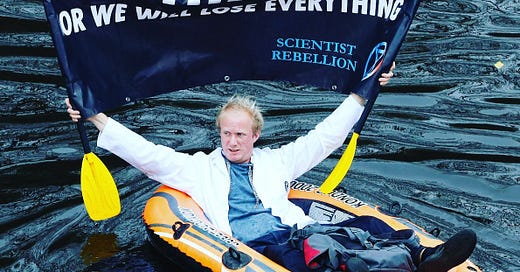Challenging Mainstream Climate Absurdities; Universities: From Objectivity to Activism; + Climate Policies = Wealth Redistribution
The centralization of power and wealth through climate policy reveals a system more concerned with economic dominance than decarbonization.
Challenging Mainstream Climate Absurdities
Hockey stick graphs, which depict a sharp rise in recent temperatures, have become a central tool for promoting climate alarmism. The latest claim—that the past 12 months were the hottest in 150,000 years—is demonstrably absurd.
In the 1990 IPCC report, scientists acknowledged that around 5,000 years ago, during the Holocene Maximum, Earth was significantly warmer than it is today.
Multiple sources from the early-1990s support this.
Here's another:
The past had changed dramatically by the late-1990s, thanks in no small part to rewrittings of Michael Mann.
Take a look at the IPCC Third Assessment Report from 2001 (chapter 2, on page 134) which based its new temperature reconstruction on Mann's newfound 'hockey stick':
Mann et al's 1998 paper was, however, widely derided upon publication, and with good reason. Respected American statistician and professor Edward J. Wegman was one of the first to analyze Mann's methodology and findings. He came to this conclusion:
“Overall, our committee believes that Mann’s assessments that the decade of the 1990s was the hottest decade of the millennium and that 1998 was the hottest year of the millennium cannot be supported by his analysis.”
Ouch.
More importantly though, the evidence against abrupt 1990s warming extends far deeper than scathing peer reviews.
According to the Geological Survey of Norway, 6,000–7,000 years ago, the Arctic Ocean was periodically ice-free. In contrast, current sea ice levels closely match the 30-year average, and the Arctic, even at the height of summer, is nowhere near ice free.
Sea ice has proven stable, and the polar bear population is growing quite rapidly. In fact, there are so many bears in Canada and Greenland this summer that locals are having to shoot them over safety concerns:
Another piece of evidence: 5,000 years ago, trees grew much far north than their current range. A 5,000-year-old tree stump near the Arctic Ocean in Canada shows that the closest trees were once 80 to 100 km further north. In Russia, forests extended to the Arctic coastline between 9,000 and 7,000 years ago. It must have been warmer during the Holocene Optimum than today.
The tree line rose to higher altitudes and all, suggesting warmer mountain climates.
Based on tree growth, temperatures 5,000 years ago were likely 2C higher than they are now. Historian Hubert Lamb documented this warming in Climate History in the Modern World, showing how warmer periods led to flourishing civilizations. In China, states Lamb, average annual temperatures were 2C warmer, and midwinter temperatures were 5C higher than today.
Civilizations thrived during these warm periods, particularly in Europe and China, and struggled during colder times. The key takeaway is clear: 5,000 years ago, the Earth was significantly warmer, challenging the reliability of modern hockey stick graphs.
The 1990 IPCC graphs, which showed the Holocene Maximum, are far more accurate than those to have followed.
Before Michael Mann’s rewriting of climate history 25 years ago, the data showed that Earth was warmer when CO2 levels were lower—directly contradicting the narrative that carbon dioxide controls global temperatures. The hockey stick was introduced because it showed that temperatures spiked as CO2 levels surpassed 300 parts per million. But absurdity breeds absurdity, and built upon the hockey stick's foundations, it follows that the last 12 months were the hottest in 150,000 years.
Although the data say otherwise, the catastrophic anthropogenic global warming train must keep going, no backtracking allowed.
I'll finish with a reasonable quote from Holmes (responsible for the second chart in this article):
"The recent past has known dramatic and fundamental changes of climate and environment which have affected the whole Earth, from the top of the highest mountains to the bottom of the deepest oceans. Moreover, many of these changes have occurred at surprising speeds. Although the Earth’s environment may now be changing in response to human activities, even without them, rapid and dramatic changes in the environment would occur quite naturally."
Universities: From Objectivity to Activism
In a direct challenge to traditional scientific neutrality, the authors here advocate that universities formally integrate climate activism and advocacy into academic job requirements, abandoning the pretense of objectivity.
Keep reading with a 7-day free trial
Subscribe to Electroverse Substack to keep reading this post and get 7 days of free access to the full post archives.







